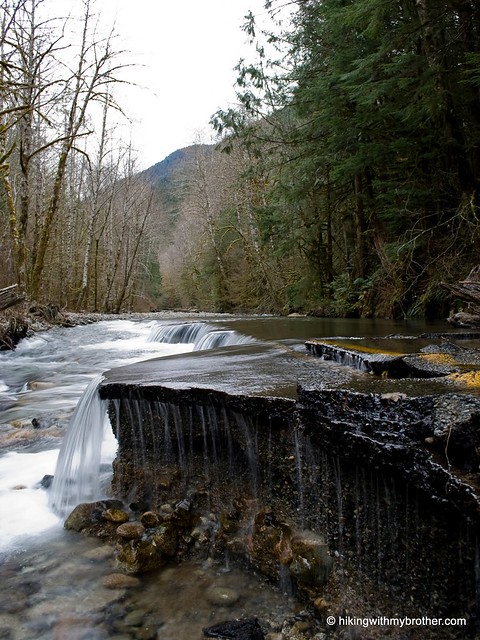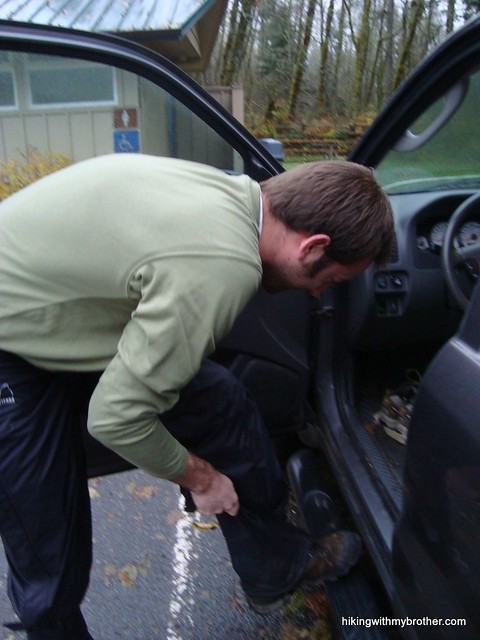Total Ascent: 1200ft
Highest Point: 2000ft
Total Distance: 11 miles
Location: N 47° 30.8520, W 121° 29.2560
Required Permit: Northwest Forest Pass
Difficulty: Moderate
 Last year, after tackling Stegosaurus Butte, we did some research and compiled a list of hikes we wanted to do in the Middle Fork Snoqualmie Valley. Less than a week after we came up with the list, a series of storms washed out large sections of the only access to the Middle Fork, Forest Road 56. Now, after months of repairs, FR 56 has been re-opened. This week we took advantage of the opening to explore the trail up to a somewhat hidden, but very impressive waterfall: Tin Cup Joe Falls.
Last year, after tackling Stegosaurus Butte, we did some research and compiled a list of hikes we wanted to do in the Middle Fork Snoqualmie Valley. Less than a week after we came up with the list, a series of storms washed out large sections of the only access to the Middle Fork, Forest Road 56. Now, after months of repairs, FR 56 has been re-opened. This week we took advantage of the opening to explore the trail up to a somewhat hidden, but very impressive waterfall: Tin Cup Joe Falls. The falls are found on Cripple Creek as waters flow out of Derrick Lake down to the Middle Fork Snoqualmie River. Cripple Creek was known as Tin Cup Joe Creek back in the 1890’s, when mining was big in the Middle Fork Valley. Local miners evidently named the creek in honor of a roving prospector. Later, for reasons we were not able to dig up, it was renamed Cripple Creek. Today, those hiking along the Middle Fork Snoqualmie Trail #1003 cross the signed Cripple Creek as they continue on to Goldmyer Hot Springs.
The falls are found on Cripple Creek as waters flow out of Derrick Lake down to the Middle Fork Snoqualmie River. Cripple Creek was known as Tin Cup Joe Creek back in the 1890’s, when mining was big in the Middle Fork Valley. Local miners evidently named the creek in honor of a roving prospector. Later, for reasons we were not able to dig up, it was renamed Cripple Creek. Today, those hiking along the Middle Fork Snoqualmie Trail #1003 cross the signed Cripple Creek as they continue on to Goldmyer Hot Springs.There is no official or very clear trail all the way to Tin Cup Joe Falls. While this makes the trip a bit tricky, it also means you’re very likely to have this stunning set of falls all to yourself. And more good news is that two-thirds of the hike is an easy stroll along the well-maintained and much loved Middle Fork Snoqualmie Trail #1003. From the Gateway Bridge follow the trail
 about five miles to Cripple Creek. On the west side of the bridge (before you cross) you should be able to make out the faint indications of a bootpath leading steeply up the hill. Take a few minutes to fuel up and get out the hiking poles - the next mile or so is not going to be easy.
about five miles to Cripple Creek. On the west side of the bridge (before you cross) you should be able to make out the faint indications of a bootpath leading steeply up the hill. Take a few minutes to fuel up and get out the hiking poles - the next mile or so is not going to be easy.Keep an eye out for the subtle signs of well-worn vegetation. At times the trail will completely disappear or take short detours around blowdowns. When in doubt, follow the creek and the path of least resistance; generally the path reappears before you know it. As you continue to struggle onwards, a distant roar will begin to grow. You’ll glimpse the first set of falls cascading down from cliffs hundreds of feet above. As you make your way down to the creek to cross it, you’ll see another set of falls just upstream and realize the creek has branched, and that you’re looking at two sets of waterfalls for the price of one.
It is tempting to make a beeline to the horsetail falls you see ahead, but don’t clamber across the creek just yet. Although not quite as impressive from the creek level, we recommend you push past these first falls and continue on to the second set of Tin Cup Joe Falls. Circle wide and scramble up the rocks above short falls to a large rocky plateau. From here, water gushes off 200’ cliffs from three separate channels invisible from the creek below. This little alcove of amazing waterfalls are among the most impressive we’ve ever seen – though we’re sure that the volume of water helped make this
 all the more spectacular. Once you catch your breath, head back down and check out those other, taller, but a little less secluded, falls.
all the more spectacular. Once you catch your breath, head back down and check out those other, taller, but a little less secluded, falls.We highly recommend this hike. Although it’s a little rough, most hikers should be able to make it up to the falls if they’re comfortable with a little bushwhacking and route finding. There’s no serious risk of getting turned around and lost with the creek as your guide, and the elevation gain is significant enough to feel, but not insurmountable. Find the time to make the trip out to Tin Cup Joe Falls – it’s well worth it.
To get there, take Exit 34 off I-90 and take a left on 468th Ave. Follow the road past the truck stop for about a half-mile until you reach SE Middle Fork Road, also known as Forest Road 56. Continue to follow the twists in the road until the pavement runs out. From here it’s almost an 11 mile gravel road to the Middle Fork Trail head parking lot. The trailhead and Gateway Bridge are at the north end of the lot. -Nathan








